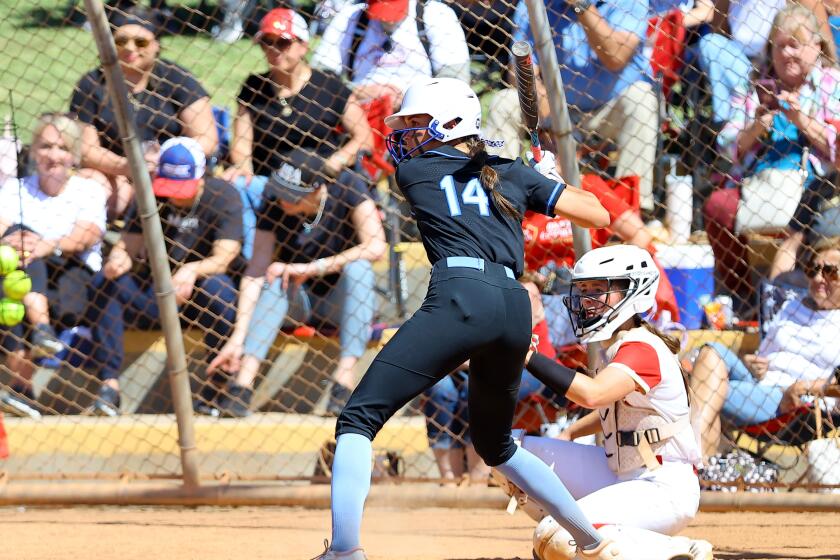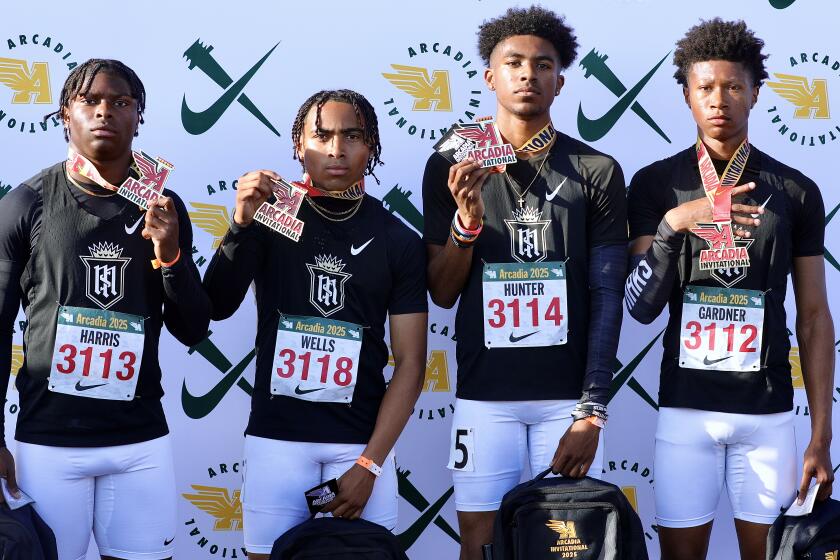Sosa Makes Journey From Rags to Glory
- Share via
PITTSBURGH — Sammy Sosa is not the person to ask about his place among the baseball legends of San Pedro de Macoris in the Dominican Republic. Sosa is not a lot of things--for starters, he is not like Mark McGwire or Ken Griffey Jr.--but he definitely is no Dominican baseball historian.
“I never had time for that,” the Chicago Cubs outfielder said before a game against the Pittsburgh Pirates the other night. He explained he had to work, shining shoes, at age 7 after his father died. When other kids were playing ball in the town known as “land of shortstops,” he was helping to feed his family by making a buck. That’s what he would get for an afternoon’s labor. “A dollar. Sometimes,” he said.
For the record, Sosa is huge in San Pedro de Macoris--for many reasons, including that he built a shopping center, and that he gave Dominican schools 250 computers this year. Sosa is big everywhere because he is the refreshing wild card in the race with McGwire and Griffey--the sport’s respective greatest draw and top all-around player--to break Roger Maris’ record of 61 home runs in a season.
With 35 so far, including a record 20 in a month (June), Sosa has put polish and luster on the baseball season. He has become a bigger celebrity in the United States than all those from his hometown: Tony Fernandez, Alfredo Griffin, Rafael Santana, Rafael Ramirez, Manny Lee, Julio Franco.
That is maybe the best part of the whole home run chase. Finally, people are getting to know who Sosa is.
It turns out he is not what many people thought he was--selfish, salary-focused, one-dimensional. He is 29, a versatile player with a .316 average (better than the other two sluggers), 86 RBIs (through Wednesday’s games) and enough speed to beat out a broken-bat grounder to short, as he did against the Pirates the other night. He is having his best year now that his team finally is contending.
“He is a very conservative, disciplined man. He’s not a little kid any more,” said general manager Ed Lynch, who took a lot of heat for signing Sosa to a four-year, $42.5 million contract extension last year.
“He is a good guy,” said Mark Grace, a teammate in a once-fractious clubhouse.
He is “Sammy Claus,” who toured U.S. hospitals under that title for two weeks last December, delivering much-sought Tamagotchi computer pets.
“I was back home (in the Dominican Republic) and I just said to my wife, ‘I’m going to go to these cities and see those children, see how they are,’ ” he said. Holding his hands about six inches apart, he added: “I saw children this big. One pound. It was something I never will forget.”
Sosa does not forget much, such as where he has been. So he reportedly gives away $500,000 a year. He bought his mother three homes (she lives in one, rents the others). He has subsidized ambulances in his home country and paid medical bills for people struggling to put food on the table.
“He does that because he used to be like that,” said Manny Alexander, the former New York Met who is Sosa’s best friend on the Cubs and who also grew up in San Pedro de Macoris.
Sammy’s mother, Lucrecia, had to find work as a maid when her husband died, and her seven children had to find whatever work they could.
“Sammy would shine shoes, his brothers would sell oranges. They were entrepreneurs in their own way,” said Mets assistant general manager Omar Minaya, the Texas Rangers scout who signed Sosa. “They were survivors, that’s what they were.”
They were survivors who used cutoff milk cartons for baseball gloves. Sammy (whose last name then was Montero before Lucrecia remarried) got to know the American owner of a local shoe factory, and occasionally got to use a condominium’s shower. It was such a novelty, he would stay in for an hour.
Sammy was even more fortunate at 16, after only two years of organized baseball, to catch Minaya’s eye. Sosa was smaller than other kids, his swing awk- wardly long. But there was something about him.
“He was very aggressive, he had lots of heart as a player. You could see he had a lot of confidence. You could tell size was not going to hamper him,” Minaya said, adding that he also saw power potential. “I thought he would be a 15-to-25 home run guy.” Minaya signed him for $3,500.
At 20, Sosa made the majors with the Texas Rangers and was traded to the Chicago White Sox. At 23, he was traded to the Cubs--and was well on his way to a dubious reputation. It was due partly to what euphemistically might be called “cultural differences,” and what others might call stereotyping. But part of it was due to his affinity for fancy jewelry and bad pitches. He struck out an awful lot for a guy who had gaudy neck- laces and vanity plates.
Bill Chase, the Dominican shoe-factory owner who now operates Sosa’s business ventures, said recently: “Sammy’s a street kid, and like all street kids, he’s extra careful of people.”
Lynch said there were other reasons why people were slamming Sammy: “He has got some flair, he’s got some flamboyance. He’s got some hot dog in him. He came to the big leagues so young, people probably overlooked the fact he was 22 or 23.”
The big contract last year was an easy target for anyone taking aim at Sosa’s rap. Bernie Williams’ agent alluded to it when he argued that his client should get a similar deal from the Yankees. “What I didn’t like about it was, Scott Boras was talking too much,” Sosa said. “He can compare me to Bernie Williams, but the rest of the stuff he said. . . . I didn’t like it too much.”
But the chorus changed its tune this year. His image shifted as quickly as he turns on a fastball. He says it is because the Cubs are better--Grace is hitting so well that Sosa wasn’t walked intentionally once during June, and fellow Dominican Henry Rodriguez has supplied left-handed power. “Last year,” Sosa said, “I’d go up to home plate trying to hit two home runs in one at-bat.”
Sosa has hit balls to right field for a change. He has taken a pitch now and then. He has left a lot of the jewelry home in the seven-bedroom, $1.2 million condominium in downtown Chicago that has space for Sosa and his wife, their four children, his mother and his brother.
“That all comes with age and maturity,” said Hall of Famer Billy Williams, the Cubs’ bench coach. “It comes with playing a lot of ballgames, growing up as an individual. Another thing, too, is he got the contract out of the way. That got him more relaxed.”
Williams has worked with Sosa for the past three years, answering the player’s requests for stories about Roberto Clemente and telling Sosa what it means to be a five-tool player (hitting, hitting for power, catching, running and throwing).
Sosa always believed his best tool wasn’t among them. “Right here,” he said, pointing to his chest. “It’s not about how big you are, it’s about what you’ve got inside, what you’ve got in your heart.”
His season and his past show what he’s got inside. The Cubs have seen things (21 home runs in 22 games) no one ever has seen. Alexander, a better historian than his countryman, thought back and said, “I saw him clean shoes, too.”
More to Read
Go beyond the scoreboard
Get the latest on L.A.'s teams in the daily Sports Report newsletter.
You may occasionally receive promotional content from the Los Angeles Times.










